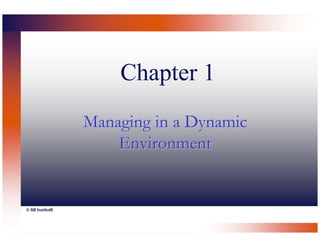More Related Content
Similar to Managing in Dynamic Environment (20)
More from Dr. C.V. Suresh Babu (20)
Managing in Dynamic Environment
- 1. Chapter 1
Managing in a Dynamic
Environment
© SB InstitutE
- 2. 1.1
Learning Objectives
After reading this chapter, you should be able to:
Define managers and management
Explain what managers do
Demonstrate knowledge of the competencies used in managerial
work by developing and practicing them
Describe the changing context of managerial work
© SB InstitutE
- 3. 1.2
A Model of Managerial Competencies
Communication
Competency
Teamwork Planning and
Competency Administration
Competency
Managerial
Effectiveness
Global Strategic
Awareness Action
Competency Competency
Self-
Management
© SB InstitutE
Competency Adapted from Figure 1.1
- 4. 1.3
Characteristics of Functional & General Managers
Functional General
Managers Managers
Example VP of Finance Store Manager
Scope of Subordinates Low High
Job
Technical Skills
High Low
“Big Picture” Thinking
Low High
© SB InstitutE
- 5. 1.4
Basic Managerial Functions
Organizing
Planning Leading
Controlling
© SB InstitutE
Adapted from Figure 1.2
- 6. 1.5
Basic Levels of Management
Top Managers
Middle Managers
First-Line Managers
Nonmanagers
© SB InstitutE
Adapted from Figure 1.3
- 7. 1.6
Dimensions of Communication Competency
Informal Communication
• Flexible and varies approach in different situations
Formal Communication
• Writes clearly, concisely and effectively, using traditional as well as
electronic media
Negotiation
• Skilled at developing relationships and exercising influence in all
directions
© SB InstitutE
Adapted from Table 1.2
- 8. 1.7
Dimensions of Planning & Administration Competency
Information Gathering, Analysis, and Problem Solving
• Takes calculated risks and anticipates consequences in a timely manner
Planning and Organizing Projects
• Plans, schedules, prioritizes tasks, delegates
responsibilities
Time Management
• Knows when to permit interruptions and when to screen them out
Budgeting and Financial Management
• Understands budgets, cash flows, financial reports, and annual reports and regularly
uses such information
© SB InstitutE
Adapted from Table 1.3
- 9. 1.8
Dimensions of Teamwork Competency
Designing Teams
• Formulates clear objectives that
inspires team members
Creating a Supportive Environment
• Acts as a coach, counselor, and mentor,
being patient with team members as they learn
Managing Team Dynamics
• Utilizes strengths and weaknesses and brings conflict into the open
© SB InstitutE
Adapted from Table 1.4
- 10. 1.9
Dimensions of Strategic Action Competency
Understanding the Industry
• Anticipates changes of competitors
and strategic partners
Understanding the Organization
• Understands the distinctive competencies of the organization
Taking Strategic Actions
• Considers the long-term implications
of actions in order to sustain and further
develop the organization
© SB InstitutE
Adapted from Table 1.5
- 11. 1.10
Dimensions of Global Awareness Competency
Cultural Knowledge and Understanding
• Stays informed of political, social and
economic trends and events around the world
• Recognizes the impact of global events on the organization
Cultural Openness and Sensitivity
• Recognizes variation of cultures and avoids stereotyping
• Is sensitive to cultural cues and is able to adopt quickly in novel
situations
• Adjusts own behavior when interacting with people of diverse
backgrounds
© SB InstitutE
Adapted from Table 1.6
- 12. 1.11
Dimensions of Self-Management Competency
Integrity and Ethical Conduct
• Has clear personal standards of integrity and ethics
• Accepts responsibility for own actions
Personal Drive and Resilience
• Seeks responsibility, shows perseverance in the face of obstacles, and bounces
back from failure
Balancing Work and Life Issues
• Strikes a reasonable balance between work and other life activities
Self-Awareness and Development
• Has clear personal and career goals and knows own values, feelings, and areas of
strengths and weakness
• Analyzes and learns from work and life experiences
© SB InstitutE
Adapted from Table 1.7
- 13. 1.12
The Evolving Structure of Organizations
1990
1980
2000
© SB InstitutE
Adapted from Figure 1.4

